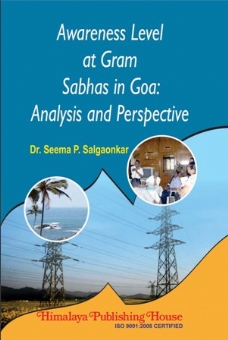This project ‘Awareness at Gram Sabhas in Goa: Analysis and Perspective’ funded by ICSSR – New Delhi was completed in the period 2011-2013. But the seeds for this study were sown much earlier, somewhere in 2008, when Government of Goa declared its intention to implement Regional Plan 2011. This move of the Government stirred up entire Goa, shaking up every village and forcing the villagers to shed their ‘sussegad’ attitude (a feature attributed to Goan people which means a carefree, joy and frolic loving people). The villagers realized that they cannot shy away from their responsibilities.
The Goa Government’s decision to implement Regional Plan 2011 came as a rude shock, and it led to a wave of awareness and participative politics at grassroots. People began to attend Gram Sabhas to know more about the regional plan and its effect on them. In the initial stages they were concerned with their personal interests, wanting to know how best they could benefit in their individual capacity if this plan was implemented. They also apprehended that the plan may harm their personal belongings like their farms, their properties, the access to their houses, their cattle sheds or even their own homes.
This study is divided into seven chapters:
Chapter I – Introduction
Chapter II – Increasing Participation at Gram Sabha and Changing Paradigm of Democracy
Chapter III – Corruption at Grassroots and Role of Gram Sabha
Chapter IV – Impact of Trust on People’s Participation at Grassroots
Chapter V – Case Studies
Chapter VI – Reforming Gram Sabha
Chapter VII – Summing up and Major Findings of the Study
The study is the outcome of both quantitative as well as qualitative research. In fact, though I began with the assumption that there is noticeable change in Gram Sabha participation in recent times, I was pleasantly surprised to find that the sample analyses reflected that there was a drastic positive change in participation, much in contrast to the trends observed elsewhere in the country. The reasons for this change also were less generic and more specific. The study reflected that the burning issues such as incessant illegal mining, uncontrolled mushrooming of mega projects, garbage problem, unchecked corruption, were the causes for this change. It was heartening to note that out of 890 respondents interviewed, 636 respondents said that they attended Gram Sabha in recent times. It was observed that almost every village in six talukas out of twelve talukas of Goa, is deeply affected due to incessant mining. The coastal villages are bearing the brunt of garbage menace and ghosts of megaprojects. Some Panchayats are facing problems due to migrant inflow. The positive shift in participation is counter reaction to these issues. There is also a rising shift in participation of women at Gram level, and this is a welcoming trend.
I owe gratitude to ICSSR – New Delhi for providing financial assistance for completing this project and for granting Grant in aid to publish the same. I thank all my respondents (Gram Sabha members) for sharing their time and providing me with valuable information. I also thank the Sarpanchas and Panchas (elected representatives) for their responses. I record my thanks to the local dailies, The Navhind Times, The Times of India, Goa and Lokmat whose daily news indirectly contributed a lot to this study.
Contents –
1 Introduction
2. Increased Participation at Gram Sabha and Changing Paradigm of Democracy
3. Corruption at Grassroots and Role of Gram Sabha
4. Impact of Trust on People’s Participation at Grassroots
5. Case Studies
6. Reforming Gram Sabha
7. Summing up and Major Findings of the Study
Bibliography
Glossary and Abbreviation






